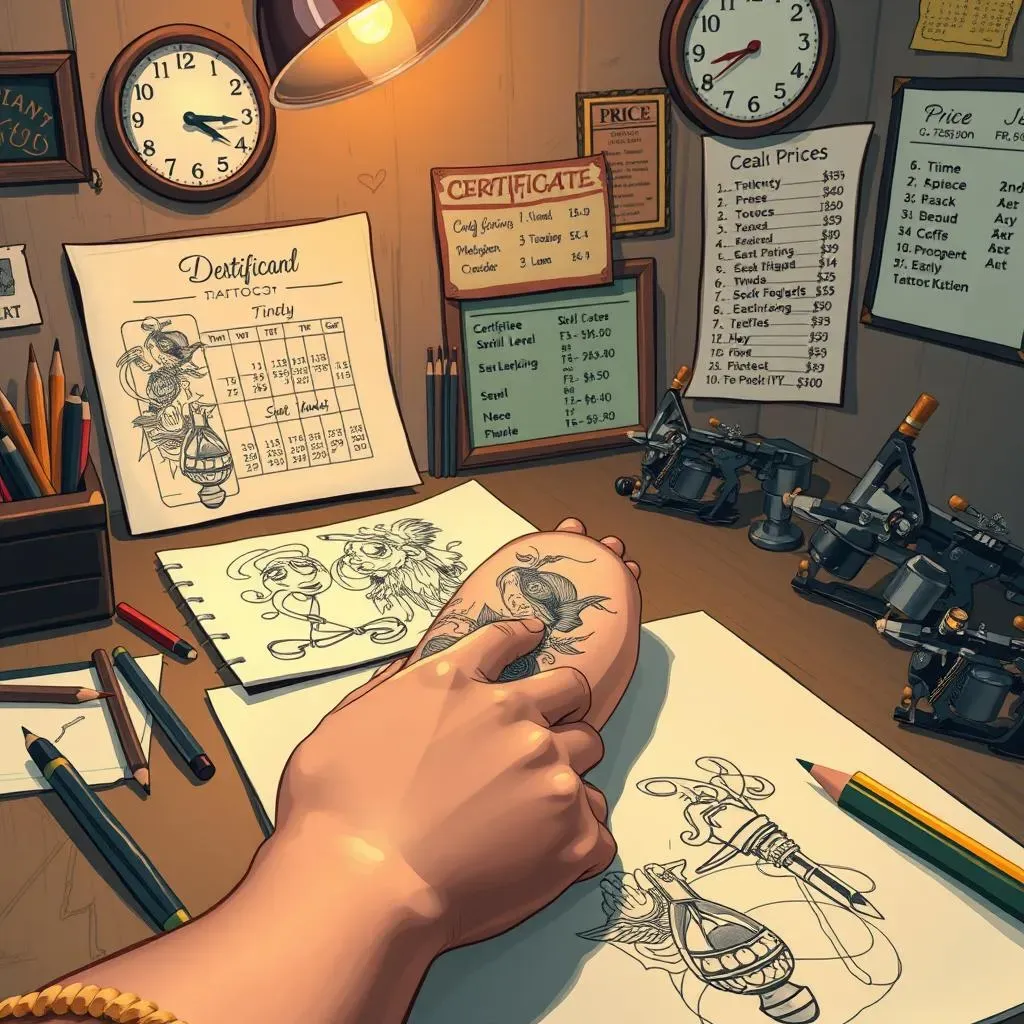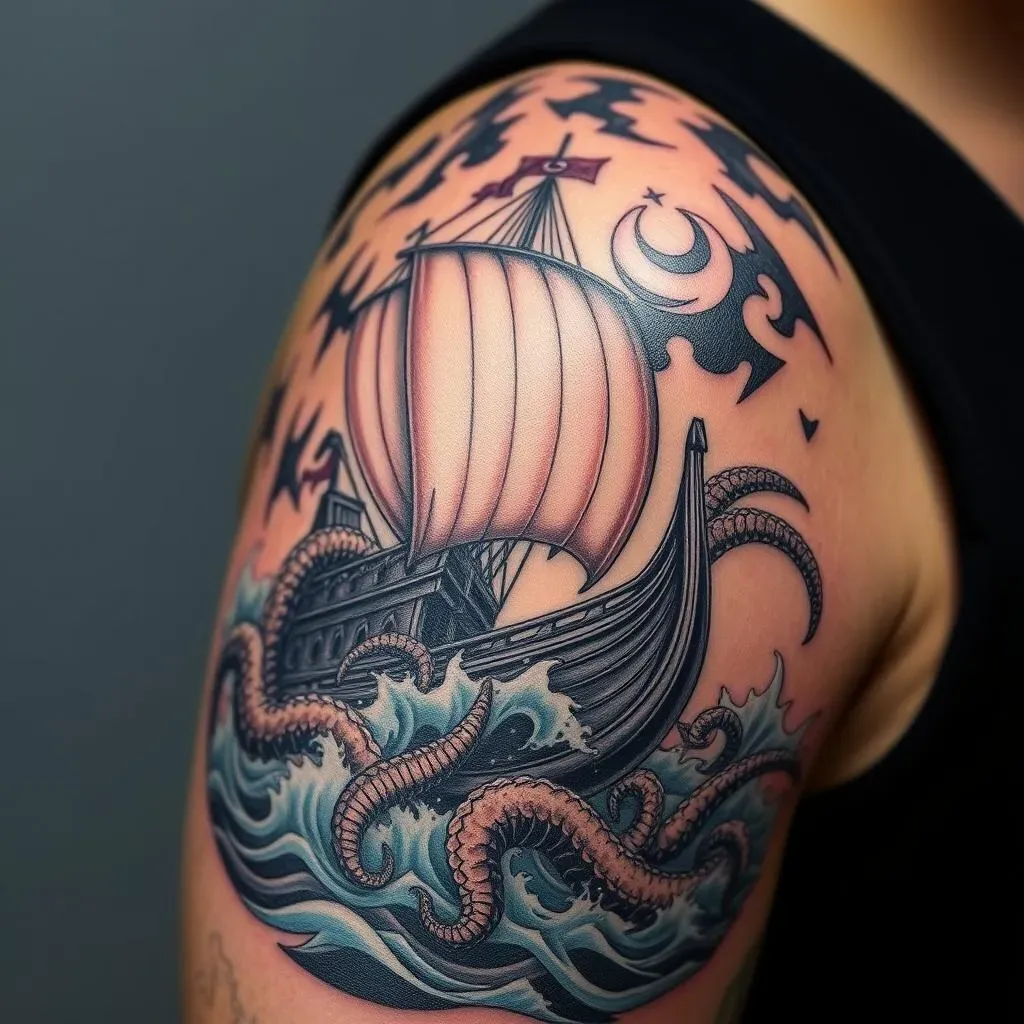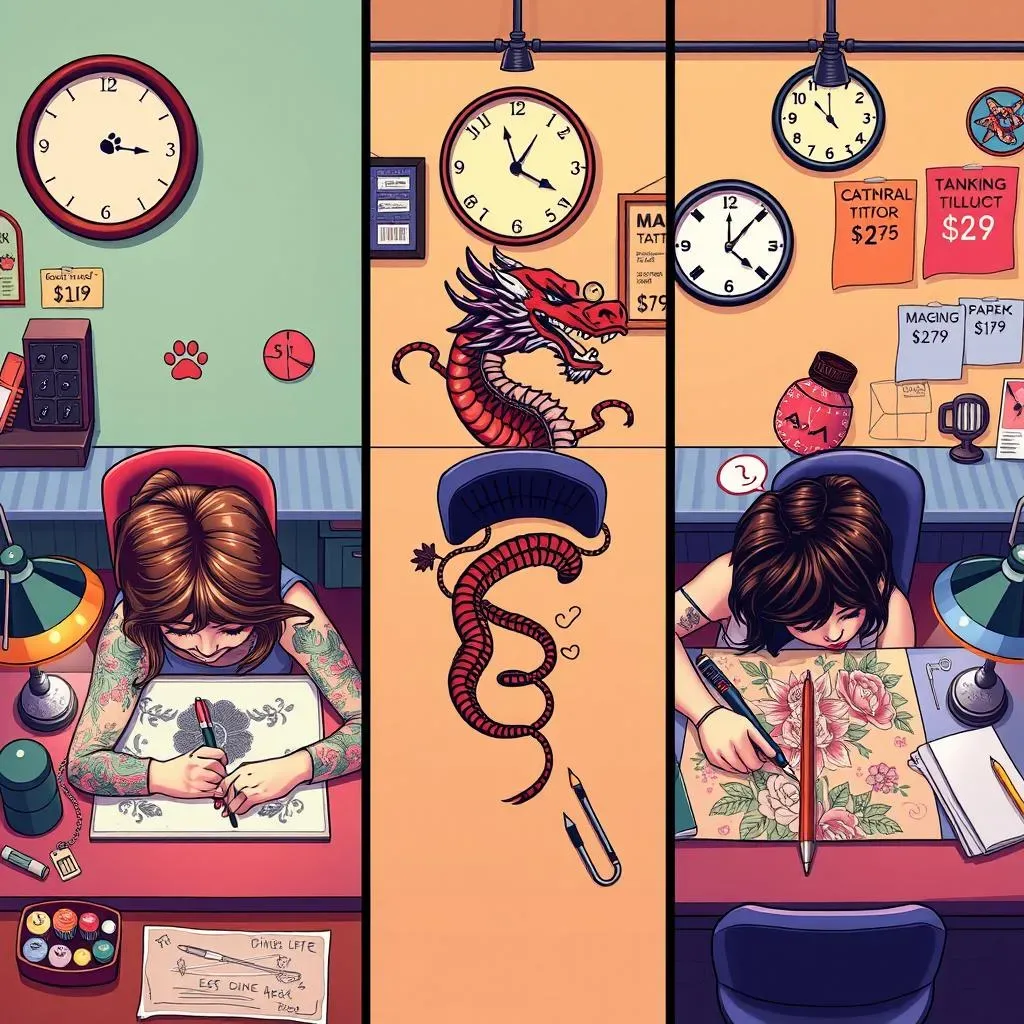Table of Contents
So, you're diving into the world of tattoo design, or maybe you're already creating awesome artwork but struggling with the money side? You're not alone. Figuring out how to price tattoo designs can feel like navigating a minefield. Charge too little, and you undervalue your talent and time. Charge too much, and you risk losing clients. This guide cuts through the confusion. We'll break down the key factors that influence pricing, from your time and skill to the complexity of the design and what the market will bear. We'll also look at real-world examples to give you a practical understanding of different pricing strategies. By the end, you'll have a solid framework for setting prices that are fair to both you and your clients, ensuring your tattoo design business thrives. Ready to get started? Let's dive in!
Understanding the Factors That Influence Tattoo Design Prices
Understanding the Factors That Influence Tattoo Design Prices
so you're trying to figure out how much to charge for your tattoo designs? It's not just about pulling a number out of thin air. Several factors come into play, and understanding them is crucial for setting prices that are both fair to you and appealing to your clients. First off, think about your time. How long does it realistically take you to create a design from start to finish? Then, consider your skill level. Are you a seasoned pro with years of experience, or are you just starting out? Your expertise definitely commands a higher price. Also, the complexity of the design matters. A simple line drawing will naturally cost less than a full-color, hyper-realistic piece. Finally, don't forget to factor in the cost of materials and any overhead expenses you might have.
But it's not all about the tangible stuff. The perceived value of your work also plays a significant role. What makes your designs unique? Do you have a particular style that sets you apart? Are you known for creating custom pieces that perfectly capture your clients' visions? All of these things add value and justify a higher price point. And of course, you need to be aware of what other designers in your area are charging. You don't want to price yourself out of the market, but you also don't want to undervalue your work by undercutting everyone else. Finding that sweet spot is key.
Factor | Description | Impact on Price |
|---|---|---|
Time | Hours spent on design | Directly increases price |
Skill Level | Experience and expertise | Higher skill = higher price |
Complexity | Intricacy of the design | More complex = higher price |
Materials & Overhead | Software, equipment, studio costs | Adds to the base cost |
Perceived Value | Uniqueness, style, customization | Justifies a premium price |
Market Rates | Competitor pricing | Influences price range |
StepbyStep: Calculating Your Base Rate for Tattoo Designs
StepbyStep: Calculating Your Base Rate for Tattoo Designs
Alright, let's get down to brass tacks and figure out your base rate! This is the foundation upon which all your pricing will be built. Think of it as your "bare minimum" – the absolute lowest you're willing to accept for your time and effort. The simplest way to approach this is by calculating an hourly rate. Start by considering your expenses: software subscriptions (like Procreate or Adobe Creative Suite), hardware costs (tablets, styluses), electricity, internet, and any other business-related expenses. Add all of that up for a month, and then divide it by the number of hours you plan to work on designs. This gives you a rough idea of your overhead cost per hour.
Next, think about your desired salary. What do you want to earn per year? Divide that by the number of weeks you plan to work, and then by the number of hours you plan to work per week. This gives you your desired hourly rate. Now, add your overhead cost per hour to your desired hourly rate. The result is your base hourly rate for tattoo designs. But remember, this is just a starting point. You'll need to adjust it based on your skill level, the complexity of the design, and other factors we discussed earlier. Don't be afraid to experiment and see what works best for you!
To make it easier, let's break it down in a list:
- Calculate Monthly Expenses: List all business-related costs.
- Determine Desired Salary: How much do you want to earn annually?
- Calculate Hourly Rate: Divide your desired salary by the number of hours you'll work.
- Add Overhead: Combine your hourly rate with your overhead cost per hour.
- Adjust Accordingly: Tweak based on skill, complexity, and market rates.
Adding Value: Justifying Higher Prices for Complex Tattoo Designs
Adding Value: Justifying Higher Prices for Complex Tattoo Designs
Why Complexity Commands a Higher Price
So, you've got a client who wants a sleeve featuring a detailed Viking longship battling a kraken in a stormy sea? Awesome! But that's not a $50 design, my friend. Complex tattoo designs demand higher prices for a reason. Think about the sheer amount of time and effort involved. Intricate linework, multiple colors, shading, and the overall level of detail all contribute to the design's complexity. The more complex the design, the more time you'll spend perfecting it, and your time is valuable. It's not just about the hours, either. Complex designs require a higher level of skill and expertise. You need to be able to execute fine details, create smooth gradients, and understand how different colors will interact on the skin. This level of mastery deserves to be compensated accordingly.
It's also essential to consider the emotional investment involved. Complex designs often tell a story or have deep personal meaning for the client. You're not just creating a pretty picture; you're bringing their vision to life and creating a lasting piece of art that they'll cherish forever. This level of emotional connection adds significant value to your work.
Highlighting the Unique Aspects of Your Work
Now, how do you communicate this value to your clients? It starts with showcasing your portfolio. Make sure you have high-quality photos of your best complex designs. Highlight the details, the shading, and the overall impact of the piece. When discussing a new project with a client, take the time to explain your process. Walk them through the steps involved in creating a complex design, from the initial sketch to the final rendering. Explain the challenges involved and how you plan to overcome them. This will help them understand the level of skill and effort required and justify the higher price tag.
Don't be afraid to talk about your experience and expertise. Let them know how many years you've been designing tattoos and what kind of training you've received. Mention any awards or recognition you've received for your work. This will help build their confidence in your abilities and make them more willing to pay a premium price. And of course, be transparent about your pricing. Explain how you calculate your rates and why complex designs cost more. Break down the costs involved, such as your hourly rate, materials, and any other expenses. This will help them understand where their money is going and feel like they're getting a fair deal.
Setting Clear Expectations and Communicating Value
One of the best ways to justify higher prices for complex tattoo designs is to set clear expectations from the outset. Before you even start working on the design, have a detailed consultation with the client. Discuss their vision, their budget, and their expectations. Explain the challenges involved in creating a complex design and how much time it will likely take. Provide them with a written estimate that outlines all the costs involved. This will help avoid any surprises down the road and ensure that everyone is on the same page. Throughout the design process, keep the client updated on your progress. Share sketches, progress photos, and any other relevant information. This will help them feel involved in the process and appreciate the amount of work you're putting in. And most importantly, be responsive to their feedback. If they have any concerns or suggestions, address them promptly and professionally. This will show them that you value their input and are committed to creating a design that they'll love.
Ultimately, justifying higher prices for complex tattoo designs comes down to communicating value. You need to show your clients that your work is worth the investment. By highlighting your skills, your experience, and the unique aspects of your designs, you can convince them that you're the right person for the job, regardless of the price.
Strategy | Description | Benefit |
|---|---|---|
Showcase Portfolio | Display high-quality photos of complex designs. | Demonstrates skill and expertise. |
Explain Process | Walk clients through the design steps. | Highlights the effort and expertise involved. |
Share Experience | Mention years of experience and training. | Builds confidence in your abilities. |
Provide Estimates | Offer detailed written estimates. | Avoids surprises and ensures transparency. |
Communicate Value | Emphasize the uniqueness and emotional connection. | Justifies the higher price point. |
Competitive Analysis: How to Price Your Tattoo Designs in the Market
Competitive Analysis: How to Price Your Tattoo Designs in the Market
Know Your Competition: Researching Local Tattoo Artists
Alright, so you've got a handle on your base rate and how to value complex designs. Now it's time to peek over the fence and see what the other tattoo artists in your area are charging. This isn't about copying them, but about understanding the landscape. Start by identifying your direct competitors – those artists who offer similar styles and quality of work as you do. Check out their websites, social media pages, and online portfolios. Pay attention to their pricing structures. Do they charge by the hour, by the piece, or a combination of both? What's their minimum price? Do they offer discounts or packages? Also, read reviews from their clients. What are people saying about their prices? Are they perceived as being fair and reasonable? This research will give you a good sense of the market rates in your area.
Don't just focus on the price, though. Look at the overall value proposition. What are your competitors offering in terms of experience, expertise, customer service, and the overall tattoo experience? Are they located in a high-traffic area? Do they have a fancy studio with all the latest equipment? These factors can all influence their pricing. Once you've gathered this information, you can start to position yourself in the market. Are you going to be the low-cost option, the premium option, or something in between? Your decision will depend on your target audience, your skill level, and your overall business strategy.
Finding Your Niche: Differentiating Your Pricing Strategy
so you've done your research and you know what the other tattoo artists in your area are charging. Now it's time to figure out how you're going to differentiate yourself. One way to do this is by specializing in a particular style or niche. Are you known for your intricate blackwork designs? Or maybe you're a master of watercolor tattoos. By focusing on a specific area, you can position yourself as an expert and justify a higher price point. Another way to differentiate yourself is by offering a unique customer experience. Do you provide in-depth consultations to help clients develop their ideas? Do you create custom designs that are tailored to their individual preferences? Do you offer a comfortable and relaxing studio environment? All of these things can add value to your services and justify a higher price.
Also, consider offering different pricing options to cater to a wider range of clients. For example, you could offer a basic design package for simpler tattoos, and a premium package for more complex designs. You could also offer hourly rates for larger projects, and fixed prices for smaller tattoos. By providing flexibility and choice, you can attract more clients and increase your overall revenue. Just be sure to clearly communicate your pricing structure and the value of each option. Transparency is key to building trust and ensuring that clients feel like they're getting a fair deal.
- Specialize in a Niche: Blackwork, watercolor, etc.
- Offer Unique Customer Experience: In-depth consultations, custom designs.
- Provide Different Pricing Options: Basic and premium packages.
- Clearly Communicate Pricing: Transparency builds trust.
Adjusting Your Rates: Balancing Profitability and Attracting Clients
Alright, so you've figured out your base rate, you've analyzed the competition, and you've differentiated your services. Now it's time to put it all together and set your actual prices. This is where the rubber meets the road, and it's important to strike a balance between profitability and attracting clients. One strategy is to start by setting your prices slightly below the market average. This can help you attract new clients and build your reputation. Once you've established yourself and have a steady stream of business, you can gradually increase your prices over time. Another strategy is to offer introductory discounts or promotions to new clients. This can be a great way to get people in the door and show them the value of your work.
It's also important to be flexible with your pricing. If a client has a limited budget, be willing to work with them to find a solution that works for both of you. Maybe you can simplify the design, reduce the size, or offer a payment plan. The key is to be creative and find ways to make your services accessible to a wider range of clients. And don't be afraid to experiment. Try different pricing strategies and see what works best for you. Track your revenue, your expenses, and your client feedback. This will help you fine-tune your pricing over time and ensure that you're running a profitable and sustainable business.
Strategy | Description | Benefit |
|---|---|---|
Start Below Market Average | Attract new clients and build reputation. | Easy to attract customers. |
Offer Introductory Discounts | Promote services to new clients. | Incentivizes trial of services. |
Be Flexible | Work with clients on a budget. | Increases accessibility. |
Experiment | Try different pricing strategies. | Optimizes profitability. |
Track Results | Monitor revenue, expenses, and feedback. | Enables informed decisions. |
RealWorld Examples: Pricing Strategies for Different Tattoo Design Scenarios
RealWorld Examples: Pricing Strategies for Different Tattoo Design Scenarios
let's get into some actual scenarios to solidify this "how to price tattoo designs" thing. Imagine Sarah, a new tattoo artist, gets asked to design a small, simple black linework tattoo of a paw print. It'll take her about an hour. Considering her base rate is $60/hour, she might charge a flat fee of $75-$100. This covers her time and a little extra for the design itself. Now, picture Mark, a seasoned artist, approached for a full-back piece featuring a detailed Japanese dragon with vibrant colors and intricate scales. This could take him weeks, involving multiple consultations and revisions. He'd likely charge an hourly rate, say $150-$250, with a significant deposit upfront to cover his time and commitment. The total cost could easily be in the thousands. Finally, consider Lisa, a mid-level artist, designing a custom floral piece for a client's shoulder. It's moderately complex, with shading and some color, taking her around 5 hours. She might charge an hourly rate of $100 or a flat fee of $400-$600, depending on her market and the client's budget.
Wrapping Up: Confidently Pricing Your Tattoo Designs
Mastering how to price tattoo designs is a journey, not a destination. It’s about understanding your worth, knowing your market, and communicating clearly with your clients. There's no magic number, but by considering the factors we've discussed – time, complexity, value, and competition – you can arrive at prices that reflect your expertise and ensure your business remains sustainable. Keep experimenting, keep learning, and keep creating amazing art. Your pricing strategy will evolve as you do, and that’s a good thing. Now go out there and confidently price your tattoo designs!